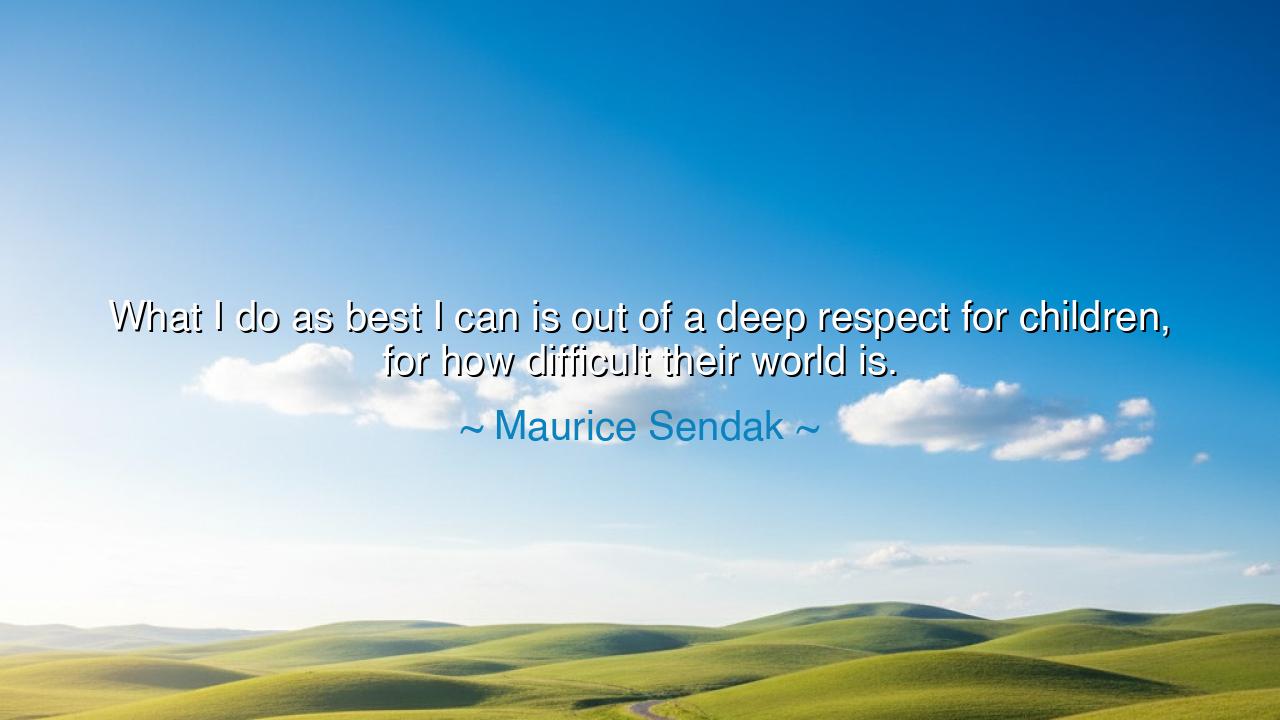
What I do as best I can is out of a deep respect for children
What I do as best I can is out of a deep respect for children, for how difficult their world is.






The words of Maurice Sendak—“What I do as best I can is out of a deep respect for children, for how difficult their world is.”—rise from the heart of an artist who understood the fragile and fierce struggles of the young. Sendak, the creator of Where the Wild Things Are, knew that childhood is not merely a season of innocence and play, but also of fear, confusion, and longing. His art, his stories, his drawings were not sentimental disguises, but honest reflections of the storms and wonders within the child’s soul. In this quote, he reveals his guiding principle: that to serve the young is not to condescend, but to stand in awe of their courage in facing a world often too great for their small shoulders.
The ancients too recognized the sacredness of childhood. In the sayings of the philosophers, the child was seen as the beginning of wisdom, a soul nearer to truth than the aged, for the young still possessed wonder unclouded by cynicism. Yet they also saw the difficulty of a child’s life: the helplessness before the strength of adults, the vulnerability to cruelty or neglect, the burden of being shaped by forces one cannot control. Sendak’s words carry this same recognition—that the child’s world is no paradise, but a battlefield where imagination becomes both shield and sword.
One can look to history for proof of this truth. Anne Frank, though only a young girl, left behind words that still cut through time. Trapped in hiding, hunted by hatred, she bore the weight of a cruel world upon her tender years. Yet she wrote of hope, of beauty, of resilience. Her diary reveals both the difficulty of the child’s world and the astonishing strength with which children endure it. Sendak, though speaking in the context of art, gives voice to the same reverence—that children are worthy not of pity alone, but of respect for their endurance and imagination in the face of hardship.
Sendak himself was shaped by the shadow of the Second World War, by stories of relatives lost in the Holocaust, by a childhood where terror and grief were never far away. It was from this soil of sorrow that his empathy for children grew. He knew their fears were real, their monsters not trivial, their anxieties not easily dismissed. Thus, when he crafted his stories, he did so not to deceive children with false cheer, but to arm them with truth wrapped in wonder. His respect was not the shallow kindness of adults who look down, but the reverence of one who looks across and says: I see you, and I honor your struggle.
The lesson is profound. Too often adults dismiss the fears of children as small, forgetting that to a child, even small fears loom large. Too often they speak down to the young, rather than meeting them with honesty and care. Sendak teaches us that to truly love children is to give them the dignity of truth, to acknowledge their courage, and to provide them tools—whether stories, comfort, or guidance—to navigate the storms of their world.
Practically, this means listening deeply when a child speaks, honoring their feelings instead of dismissing them, and giving them space to imagine, create, and question. It means recognizing that even in play, children wrestle with the same forces—fear, love, loss, hope—that adults face, though in their own ways. It means crafting homes, schools, and communities that nurture resilience, not by denying life’s difficulties, but by preparing the young to face them with courage.
Thus, Sendak’s words are both confession and commandment. He tells us that his work is born of respect, not superiority, and he charges us to do likewise. Let us see in children not merely innocence to be preserved, but warriors in training, bearing battles unseen. Let us not shield them with lies, but walk beside them with truth. For in honoring the difficulty of their world, we teach them that they are not alone, and we prepare them to grow into adults who, in turn, will honor those who come after them.






AAdministratorAdministrator
Welcome, honored guests. Please leave a comment, we will respond soon